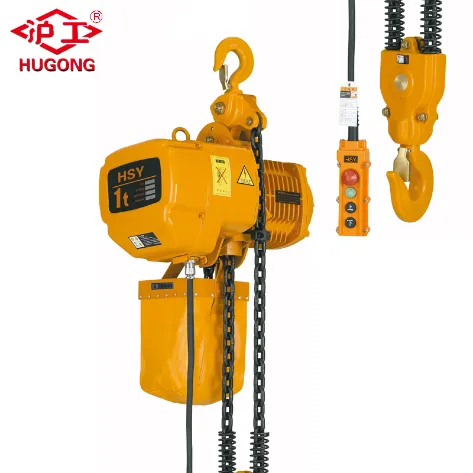
- English
- Español
- Português
- русский
- Français
- 日本語
- Deutsch
- tiếng Việt
- Italiano
- Nederlands
- ภาษาไทย
- Polski
- 한국어
- Svenska
- magyar
- Malay
- বাংলা ভাষার
- Dansk
- Suomi
- हिन्दी
- Pilipino
- Türkçe
- Gaeilge
- العربية
- Indonesia
- Norsk
- تمل
- český
- ελληνικά
- український
- Javanese
- فارسی
- தமிழ்
- తెలుగు
- नेपाली
- Burmese
- български
- ລາວ
- Latine
- Қазақша
- Euskal
- Azərbaycan
- Slovenský jazyk
- Македонски
- Lietuvos
- Eesti Keel
- Română
- Slovenski
- मराठी
- Srpski језик
The Essential Guide to Electric Hoists: Power, Precision, and Safety in Heavy Lifting
2024-11-05
In industries that require heavy lifting, from construction sites to manufacturing plants, electric hoists have become indispensable tools. They offer a safe, efficient, and powerful way to lift and move loads that would otherwise be impossible or incredibly labor-intensive to handle manually. Whether you're raising building materials to the top of a skyscraper or lifting a heavy machine part in a factory, electric hoists are there to make the job easier and more efficient.
In this blog, we’ll dive into the world of electric hoists, exploring their components, types, uses, advantages, and safety features that make them an essential piece of equipment across various industries.
What Is an Electric Hoist?
An electric hoist is a mechanical lifting device powered by an electric motor. It is designed to lift or lower heavy loads with the help of a chain or wire rope, which is wound around a drum or sprocket. The motor drives the lifting mechanism, allowing the operator to control the movement of the load via pendant controls, remote controls, or push buttons.
Electric hoists are used in a variety of industries, ranging from construction and manufacturing to entertainment and automotive. They help speed up processes, improve precision, and ensure safety while handling heavy items.
Components of an Electric Hoist
Understanding the basic components of an electric hoist will help you appreciate how it works and how it can be used effectively in various applications.
1. Electric Motor: The core of the hoist, the electric motor drives the lifting mechanism. It is powered by electricity and can range in power depending on the load capacity of the hoist.
2. Lifting Mechanism: The chain or wire rope is the component that physically lifts the load. When the motor runs, it moves the chain or rope, raising or lowering the load.
3. Drum or Sprocket: The lifting mechanism is wound around a drum (for wire ropes) or sprocket (for chains). This allows the chain or rope to be reeled in and out as the load is lifted or lowered.
4. Control System: Most electric hoists come with a control system, either through a wired pendant control or a wireless remote. These systems allow the operator to easily and safely manage the hoist from a distance.
5. Limit Switch: A safety feature that prevents the hoist from lifting or lowering the load beyond a certain point. This protects the hoist and the load from damage.
6. Overload Protection: Some electric hoists have sensors that prevent the hoist from lifting loads that exceed its rated capacity, avoiding mechanical failure and ensuring safety.

Types of Electric Hoists
Electric hoists come in several different types, each suited for specific applications and load capacities. Here's an overview of the most common types:
1. Chain Hoists
Chain hoists use a chain to lift and lower heavy loads. These hoists are popular for lifting extremely heavy items and are often used in industrial environments, construction, and warehouses. The chain is durable and can handle the rough conditions of these environments.
- Applications: Construction, warehouses, factories, and construction sites.
- Capacity: Can handle very heavy loads, sometimes several tons.
2. Wire Rope Hoists
Wire rope hoists use a wire rope to lift and lower loads. They are typically used in applications where higher speeds or larger lifting capacities are required. Wire rope is stronger and more flexible than chains, making it ideal for high-speed operations and heavy lifting.
- Applications: Cranes, manufacturing plants, shipping yards, and material handling.
- Capacity: Can handle higher loads and work with more advanced cranes.
3. Mini Hoists
Mini electric hoists are compact, lightweight versions of standard electric hoists. They are ideal for lifting lighter loads in smaller spaces, such as home workshops or small factories. Despite their size, mini hoists still pack a punch when it comes to lifting efficiency.
- Applications: Small workshops, home garages, DIY projects.
- Capacity: Typically up to 500 kg or 1 ton.
Applications of Electric Hoists
Electric hoists are versatile and used in many industries. Here are just a few of the most common applications:
- Construction: Lifting building materials, structural components, and equipment to elevated heights. Hoists make tasks such as assembling scaffolding or lifting steel beams faster and safer.
- Manufacturing: Used in factories to move heavy equipment and materials along assembly lines. They’re also used for maintenance, lifting machinery parts for repair or replacement.
- Warehousing & Logistics: Used for lifting and moving heavy goods, boxes, and pallets in warehouses, shipping yards, and distribution centers.
- Theater & Entertainment: Hoists are used to raise heavy stage props, lighting, and sound equipment in theaters, concert venues, and other performance spaces.
- Automotive: In auto repair shops, electric hoists help lift car engines, transmissions, and other heavy components for repair and replacement.
Advantages of Electric Hoists
Electric hoists offer several benefits that make them preferable to manual hoists or other lifting methods:
1. Efficiency: Electric hoists provide faster lifting speeds, helping to increase productivity and reduce the time spent on lifting tasks.
2. Ease of Use: With controls that require minimal physical effort, electric hoists are easier to operate than manual hoists, reducing operator fatigue and increasing precision.
3. Safety: Many electric hoists come with built-in safety features like limit switches, overload protection, and emergency stop buttons, ensuring that the hoist operates within its capacity and reducing the risk of accidents.
4. Reduced Labor Costs: With an electric hoist, the need for a team of workers manually lifting loads is eliminated, reducing labor costs and increasing operational efficiency.
Safety Features of Electric Hoists
Safety is always a top priority when dealing with heavy lifting equipment. Here are some key safety features found in electric hoists:
1. Limit Switches: These prevent the hoist from exceeding its maximum travel distance, which can damage the hoist or the load.
2. Overload Protection: Most electric hoists are designed with overload protection systems that automatically stop the hoist from lifting more weight than it is rated for.
3. Emergency Stops: Panic buttons or emergency stop switches can immediately stop the hoist in case of an emergency, preventing accidents.
4. Automatic Brake Systems: Many hoists are equipped with automatic brakes that ensure the load remains secure and does not fall when the motor is stopped.
Conclusion
Electric hoists are crucial pieces of equipment for anyone who needs to lift heavy loads with precision and safety. Whether you’re working in construction, manufacturing, automotive, or entertainment, investing in the right electric hoist can help streamline operations, improve safety, and boost efficiency.
By understanding the different types of hoists, their applications, and the safety features they offer, you can make an informed decision about which hoist is best suited for your specific needs. If you want to ensure smooth and safe lifting operations, an electric hoist is an essential tool for the job!
Interested in exploring electric hoists further? Let us know in the comments below, or check out our other guides on heavy lifting and construction equipment.
As a professional China Electric Hoist manufacturers and suppliers, we provide customers with comprehensive project management services.


